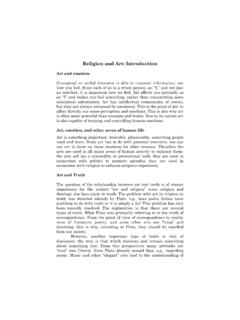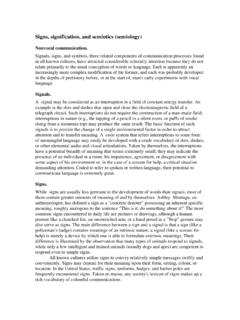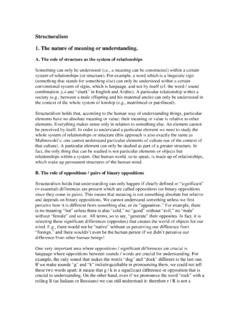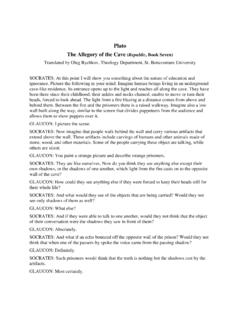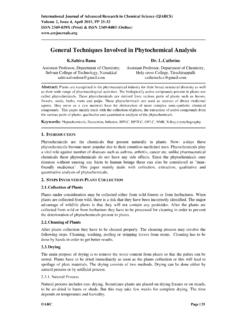Transcription of Modern Physics Notes - St. Bonaventure University
1 Modern Physics Notes J Kiefer 2006. Table of Contents TABLE OF 1. I. RELATIVITY .. 2. A. Frames of 2. B. Special Relativity .. 5. C. Consequences of the Principle of Special Relativity .. 8. D. Energy and Momentum .. 14. E. A Hint of General 19. II. QUANTUM THEORY .. 21. A. Black Body 21. B. Photons .. 27. C. Matter 30. D. 37. III. QUANTUM MECHANICS & ATOMIC STRUCTURE (ABBREVIATED) .. 45. A. Schr dinger Wave Equation One Dimensional .. 45. B. One-Dimensional 47. D. The Hydrogen 52. E. Multi-electron Atoms .. 59. 1. I. Relativity A. Frames of Reference Physical systems are always observed from some point of view. That is, the displacement, velocity, and acceleration of a particle are measured relative to some selected origin and coordinate axes. If a different origin and/or set of axes is used, then different numerical values . are obtained for r , v , and a , even though the physical event is the same. An event is a physical phenomenon which occurs at a specified point in space and time.
2 1. Inertial Frames of Reference a. Definition An inertial frame is one in which Newton's Laws of Motion are valid. Moreover, any frame moving with constant velocity with respect to an inertial frame is also an inertial frame of . reference. While r and v would have different numerical values as measured in the two . frames, F = ma in both frames. b. Newtonian relativity Quote: The Laws of Mechanics are the same in all inertial reference frames. What does the same mean? It means that the equations and formulae have identical forms, while the numerical values of the variables may differ between two inertial frames. c. Fundamental frame It follows that there is no preferred frame of reference none is more fundamental than another. 2. Transformations Between Inertial Frames a. Two inertial frames Consider two reference frames one attached to a cart which rolls along the ground. Observers on the ground and on the cart observe the motion of an object of mass m.
3 The S'- frame is moving with velocity v relative to the S- frame . As observed in the two frames: 2. x . In S' we'd measure t', x', and u x = . t . x In S we'd measure t, x, and u x = . t b. Galilean transformation Implicitly, we assume that t = t . Also, we assume that the origins coincide at t = 0. Then x = x + v x t . y = y + v y t . z = z + v z t . t = t . The corresponding velocity transformations are dx dx . ux = = + vx = u x + vx dt dt dy dy . uy = = + vy = uy + vy dt dt dz dz . uz = = + vz = u z + vz dt dt For acceleration du dv ax = x = ax + x dt dt du y dv = a y +. y ay =. dt dt du dv az = z = az + z dt dt . Note that for two inertial frames, the a x = a x , a y = a y , and a z = a z . 3. Example S- frame / / /. / du dp F = ma = m = , if m is constant. dt dt S'- frame / / / / / /. / dp / / / / / du dv du /. F = ma = , where p = mu . But u = u v , so F = m =m = F . That is, dt dt dt dt / /. a = a , as they must for 2 inertial reference frames. Notice the technique.
4 Write the 2nd Law in the S'- frame , then transform the position and velocity vectors to the S- frame . 4. B. Special Relativity 1. Michelson-Morley a. Wave speeds Midway through the 19th century, it was established that light is an electromagnetic (E-M) wave. Maxwell showed that these waves propagate through the vacuum with a speed c 3 x10 8 m/sec. Now, wave motion was well understood, so it was expected that light waves would behave exactly as sound waves do. Particularly the measured wave speed was expected to depend on the frame of reference.. In the S- frame , the speed of sound is u ; in the S'- frame the speed is u . The source and the / / /. medium are at rest in the S- frame . We find (measure) that u = u + v , in conformity with Newtonian or Galilean relativity. We may identify a preferred reference frame , the frame in which the medium is at rest. b. Michelson-Morley Throughout the latter portion of the 19th century, experiments were performed to identify that preferred reference frame for light waves.
5 The questions were, what is the medium in which light waves travel and in what reference frame is that medium at rest? That hypothetical medium was given the name luminiferous ether ( ther). As a medium for wave propagation, the ether must be very stiff, yet offer no apparent resistance to motion of material objects through it. The classic experiment to detect the ether is the Michelson-Morley experiment. It uses interference to show a phase shift between light waves propagating the same distance but in different directions. The whole apparatus (and the Earth) is presumed to be traveling through the . ether with velocity, v . A light beam from the source is split into two beams which reflect from the mirrors and are recombined at the beam splitter . forming an interference pattern which is projected on the screen. Take a look at 5. the two light rays as observed in the ether rest frame . The sideward ray: The time required for the light ray to travel from the splitter to the mirror is obtained from 1.
6 V2 2. (ct ) = + (vt ) t = 1 2 . 2 2 2.. c c . Now c >> v, so use the binomial theorem to simplify 1 v2 . n(n + 1) 2 t 1 + . (1 x) n = 1 + nx + x + c 2 c 2 . 2! 2 1 v 2 . The total time to return to the splitter is twice this: t1 = 2t 1 + . c 2 c 2 . For the forward light ray, the elapsed time from splitter to mirror to splitter is 2 v 2 2 v 2 . t2 = + = 1 2 1 + 2 . c v c+v c c c c .. The two light rays recombine at the beam splitter with a phase difference [let = .]: c t c 2 1 v 2 c v 2. = (t 2 t1 ) = = . c 2 c2 c2. t Since 0 , the two light rays are out of phase even though they have traveled the same . distance. By measuring t one could evaluate v .. However, no such phase difference was/is observed! So, there is no ether, no v with respect to such an ether. This null result is obtained no matter which way the apparatus is turned. The conclusion must be that either the Laws of electromagnetism do not obey a Newtonian relativity principle or that there is no universal, preferred, rest frame for the propagation of light waves.
7 C. Expedients to explain the null result length contraction movement through the ether causes the lengths of objects to be shortened in the direction of motion. ether-drag theory ether is dragged along with the Earth, so that near the Earth's surface the ether is at rest relative to the Earth. 6. Ultimately, the expedients were rejected as being too ad hoc; it's simpler to say there is no ether. This still implies that the Laws of electromagnetism behave differently under a transformation from one reference frame to another than do the Laws of mechanics. 2. Postulates of Special Relativity a. Principle of Special Relativity It doesn't seem sensible that one part of Physics should be different from another part of Physics . Let's assume that they are not different, and work out the consequences. This is what Einstein did. He postulated that All the Laws of Physics are the same in all inertial reference frames.'. b. Second Postulate The second postulate follows from the first.
8 The speed of light in a vacuum is (measured to be). the same in all inertial reference frames.'. When the speed of light is measured in the two reference frames, it is found that c c + v , rather c = c . Evidently, the Galilean Transformation is not correct, or anyway not exact. In any case, we assume the postulates are true, and work out the consequences. 7. C. Consequences of the Principle of Special Relativity 1. Time Dilation a. Events An event may be regarded as a single observation made at a specific location and time. One might say that an event is a point in space-time (x,y,z,t). Two events may be separated by intervals in either space or in time or in both. b. Time intervals Consider a kind of clock: We observe two events: i) the emission of a flash at O' and ii) the reception of the flash at O'. In this case, x = y = z = 0 . The 2d . time interval between the two events is t = . c Now let's view the same two events from the point of view of another frame , S.
9 As shown below, the S'- frame is moving to the right with speed v relative to the S- frame . In the S- frame , x 0 . 2d The elapsed time is t = , where d 2 = d 2 + 2 . Substitute for c d , d , and in terms of t , t , c, and v. c 2 t 2 c 2 t 2 v 2 t 2. = +. 4 4 4. 1. c2 2. t . Solve for t = t 2 . 2 . = . c v v2. 1 2. c example (prob. 1-11 in the text). The lifetime of a pion in its own rest frame is t = x10 8 sec. Consider a pion moving with speed v = in a lab what will be measured as its lifetime in the lab? 8. t x10 8 sec x10 8 sec t = = = = 8 sec . v2 1 2 1 . c2. The lifetime of a fast-moving particle is measured by noting how far it travels before decaying. In this example = v t = 8 sec = m. In practice, we measure and compute t . c. Proper time The proper time is the time interval measured by an observer for whom the two events occur at the same place, so that x = y = z = 0 . 2. Length Contraction a. Contraction . Consider an object, such as a meter stick, of length L in its own rest frame , S.
10 A second frame , S', moves to the right with a speed v relative to S. We observe two events: i) the point A passes the left end of the stick ii) the point A passes the right end of the stick. As measured in the S' frame , L = v t . and x = 0 . 9. t v2 v2. In the S frame , x = L and t = . Therefore, L = v t 1 = L 1 2 . v2 c2 c 1 2. c An observer in the S' frame observes the stick to be shorter (contracted) than does the observer in the S frame . Notice particularly that the stick is at rest in the S frame . The contraction takes place in the direction of the relative motion. Lengths perpendicular to v are not affected. So for instance in the situation discussed above the width and thickness of the meter stick are still measured the same in both reference frames. b. Proper length The proper length of an object is that length measured in the rest frame of the object. 3. Simultaneity a. Space-time Each event has associated with it four numbers: x, y, z coordinates and a value of time which we read off a clock located at that spatial location.
